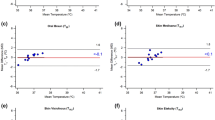Summary
A model office for 4 persons was air conditioned by an induction apparatus, the air current passing in a transverse direction. The rate of change of air, the room temperature and the temperature difference between the room air and primary air (Δt) were varied. The skin temperatures on the forehead, chest, hands and feet, the rectal temperature and blood pressure were measured in two men and two women. Air temperatures were measured close to the subjects at the levels of the head, chest and feet (microclimate). Wind speed at four different levels was measured every 10 min. At the same time the subjects were questioned about their reaction to the climatic conditions.
Skin temperatures on the hands and feet showed definite changes. Deviations of −1,9 ° C from the average temperature of 32,3 °C on the hand were judged by the subjects as too cold; deviations of +1,7 °C were considered too warm. Changes of temperatures on the feet gave similar results though not so marked. Thus the subjective response was in accordance with the change in the measured skin temperatures on the hands and feet.
In addition the subjective sensation of draught was closely related to the fall in skin temperatures on the hands and feet. The skin temperature on the forehead changed much less than the temperature on feet and hands. Therefore it is apparently not so useful an indicator of the state of the climate.
The following temperatures proved to be comfortable, too cold or too warm: 24.5 °C at the level of the head, and 24.0 °C at the level of the feet were comfortable; 23.7 °C at the level of the head and 23.2 °C at the level of the feet were too cold; and 26.4 °C at the level of the head and 25.9 °C at the level of the feet were too warm.
A room temperature of 24.0 °C combined with an average wind speed of 0.14 msec−1 was satisfactory.
A rate of change of air of 20 h−1 and Δt 6 °C combined with a room temperature of 24.0 ° C proved to be comfortable for all persons.
Similar content being viewed by others
Literatur
Aschoff, J.: Wärmehaushalt, Lehrbuch der Physiologie, Landois-Rosemann. München-Berlin: Urban & Sohwarzenberg 1960.
Bedford, T.: Basic principles of ventilation and heating. London: H. K.Lewis and Co. Ltd. 1948.
Burton, A. O., and O. C.Edholm: Man in a cold environment. London 1955.
Ebbbcke, U.: Der Gesichtsreflex des Trigeminus als Wärmeschutzreflex (Wind-und Wetterreflex) des Kopfes. Klin. Wschr.23, 141 (1944).
Ferris, B. G., R. E. Forster, E. L. Pillion, andW. R. Christensen: Control of peripheral blood flow: responses in the human hand when extremities are warmed. Amer. J. Physiol.150, 304 (1947).
Grandjean, E.: Physiologische Arbeitsgestaltung. Thun-München: Ott-Verlag 1963.
- Raumklimatische Wirkungen verschiedener Heizsysteme in Büros. Schweizerische Blätter für Heizung und Lüftung 1966.
Heiser, F., andL. H. Cohen: Diurnal variations of skin temperature. J. industr. Hyg.15, 243 (1933).
Koelsch, F.: Lehrbuch der Arbeitshygiene, Bd. 1: Allgem. Physiol. u. Hyg. der Arbeit. Stuttgart: Enke 1954.
Loeschcke, H. H., u. M.Schläfke: Untersuchungen zur Bewertung des Klimas in Hörsälen mit verschiedener Belüftungsführung. Die Bauverwaltung 554–560 (1966).
McConnel, W. J., and M.Spiegelmann: Reactions of 745 clerks to summerair-conditioning. Heating, Piping and Air-Conditioning12 (1940).
Recknagel, H., u.E. Sprenger: Taschenbuch für Heizung, Lüftung und Klimatechnik. München: Oldenbourg 1959.
Rein, H.: Die Einwirkung von Kältereizen im Gebiete des N. ethmoidalis ant. auf die Durchblutung der A. carotis. Z. Biol.89, 319 (1930).
Yaglou, C. R.: A.S.H.V.E. Guide (1955).
Author information
Authors and Affiliations
Additional information
Diese Untersuchungen wurden in Zusammenarbeit mit der Firma Svenska Fläktfabriken, Stockholm, durchgeführt.
Herrn Professor Dr.Loeschcke danke ich für die Beratung bei der Anlage der Experimente und beim Zustandekommen der Arbeit.
Rights and permissions
About this article
Cite this article
Schläfke, M. Klimaphysiologische Untersuchungen in einem mit Induktionsgeräten quer durchspülten Büroraum. Int. Z. Angew. Physiol. Einschl. Arbeitsphysiol. 27, 239–256 (1969). https://doi.org/10.1007/BF00696262
Received:
Issue Date:
DOI: https://doi.org/10.1007/BF00696262



